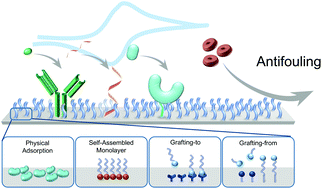Our official English website, www.x-mol.net, welcomes your
feedback! (Note: you will need to create a separate account there.)
Antifouling strategies in advanced electrochemical sensors and biosensors.
Analyst ( IF 3.6 ) Pub Date : 2020-01-09 , DOI: 10.1039/c9an02017a Pei-Heng Lin,Bor-Ran Li
Analyst ( IF 3.6 ) Pub Date : 2020-01-09 , DOI: 10.1039/c9an02017a Pei-Heng Lin,Bor-Ran Li

|
Electrochemical biosensors have been applied in a broad range of clinical applications for pathogen biomarker detection and medical applications and diagnosis due to the sensitivity of electrochemical methods and the bioselectivity of the components. The complexity of clinical conditions with various biofoulants (proteins, cells, polysaccharides and lipids) severely influences the reliability and stability of sensors for direct detection or immersion under changing conditions. Therefore, designing an antifouling sensing platform that can effectively reduce undesired binding to maintain biosensor performance in optimized analysis is necessary. For this purpose, the fundamental mechanisms of fouling materials and commonly used biocompatible antifouling components have been discussed, and the relevant effective modification strategies are introduced in this review. Recent advances in these strategies are demonstrated in examples with analysis of essential modification methods for reliable sensing in non-specific binding solutions or complex biofluids. The challenges and future perspectives of modification strategies for current clinical application are also discussed in this review.
中文翻译:

先进的电化学传感器和生物传感器的防污策略。
由于电化学方法的敏感性和组分的生物选择性,电化学生物传感器已被广泛用于病原体生物标志物检测,医学应用和诊断的临床应用中。具有各种生物污垢剂(蛋白质,细胞,多糖和脂质)的临床条件的复杂性严重影响了在变化的条件下直接检测或浸没的传感器的可靠性和稳定性。因此,有必要设计一种防污传感平台,以有效地减少不必要的结合,从而在优化的分析中保持生物传感器的性能。为此,已经讨论了污垢材料和常用的生物相容性防污成分的基本机理,并介绍了相关的有效修改策略。通过分析用于非特异性结合溶液或复杂生物流体中可靠传感的基本修饰方法的实例,证明了这些策略的最新进展。本文还讨论了当前临床应用修饰策略的挑战和未来前景。
更新日期:2020-02-17
中文翻译:

先进的电化学传感器和生物传感器的防污策略。
由于电化学方法的敏感性和组分的生物选择性,电化学生物传感器已被广泛用于病原体生物标志物检测,医学应用和诊断的临床应用中。具有各种生物污垢剂(蛋白质,细胞,多糖和脂质)的临床条件的复杂性严重影响了在变化的条件下直接检测或浸没的传感器的可靠性和稳定性。因此,有必要设计一种防污传感平台,以有效地减少不必要的结合,从而在优化的分析中保持生物传感器的性能。为此,已经讨论了污垢材料和常用的生物相容性防污成分的基本机理,并介绍了相关的有效修改策略。通过分析用于非特异性结合溶液或复杂生物流体中可靠传感的基本修饰方法的实例,证明了这些策略的最新进展。本文还讨论了当前临床应用修饰策略的挑战和未来前景。











































 京公网安备 11010802027423号
京公网安备 11010802027423号